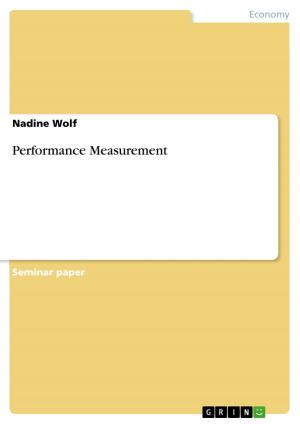| Author: | Andreas Leitner | ISBN: | 9783638375849 |
| Publisher: | GRIN Publishing | Publication: | May 9, 2005 |
| Imprint: | GRIN Publishing | Language: | English |
| Author: | Andreas Leitner |
| ISBN: | 9783638375849 |
| Publisher: | GRIN Publishing |
| Publication: | May 9, 2005 |
| Imprint: | GRIN Publishing |
| Language: | English |
Research Paper (undergraduate) from the year 2004 in the subject Business economics - Industrial Management, grade: 2, Glynd?r University, Wrexham known as NEWI (Mechanical engineering), 4 entries in the bibliography, language: English, abstract: This paper discusses the impact of SPC for an organization. What SPC can do for an organization as well as what the organization has to provide for SPC to work successfully. This paper doesn't discuss, how SPC works or how it can be installed into an organization. It discusses the requirements for SPC to work successfully as well as the output of SPC, and how it can be used for the organization to move forward, on the basis of organization, which do already use SPC successfully. (Oakland 1990 a) Statistic process control (SPC) is a strategy for reducing variability, the cause of most quality problems. Variation of products can be caused by nearly everything, delivering times, in ways of doing things, raw material, people attitudes, equipment, and its use, maintenance, and so one. SPC can help to improve processes continually by reducing its variability. The basic question therefore, which should be asked recurrently is: Can we do the job more consistently? Therefore, there must be willingness, to implement changes in every parts of business, to achieve continuous improvement. SPC is not just control; it enables reliable and consistent processes, and continuous improvement, which is important to fulfil long-term requirements of the customers, and the company. Quality can't be inspected it must be built. Therefore creating quality is not the job of the quality department, it's the job of everybody in the company. Knowledge of the current statement of the process is essential for both operational as well as strategic decisions for design and technology functions. The following questions helps to get this information, which should be asked contiguously. - Can we do the job correctly? - Are we doing the job correctly? - Have we done the job correctly? - Could we do the job better?
Research Paper (undergraduate) from the year 2004 in the subject Business economics - Industrial Management, grade: 2, Glynd?r University, Wrexham known as NEWI (Mechanical engineering), 4 entries in the bibliography, language: English, abstract: This paper discusses the impact of SPC for an organization. What SPC can do for an organization as well as what the organization has to provide for SPC to work successfully. This paper doesn't discuss, how SPC works or how it can be installed into an organization. It discusses the requirements for SPC to work successfully as well as the output of SPC, and how it can be used for the organization to move forward, on the basis of organization, which do already use SPC successfully. (Oakland 1990 a) Statistic process control (SPC) is a strategy for reducing variability, the cause of most quality problems. Variation of products can be caused by nearly everything, delivering times, in ways of doing things, raw material, people attitudes, equipment, and its use, maintenance, and so one. SPC can help to improve processes continually by reducing its variability. The basic question therefore, which should be asked recurrently is: Can we do the job more consistently? Therefore, there must be willingness, to implement changes in every parts of business, to achieve continuous improvement. SPC is not just control; it enables reliable and consistent processes, and continuous improvement, which is important to fulfil long-term requirements of the customers, and the company. Quality can't be inspected it must be built. Therefore creating quality is not the job of the quality department, it's the job of everybody in the company. Knowledge of the current statement of the process is essential for both operational as well as strategic decisions for design and technology functions. The following questions helps to get this information, which should be asked contiguously. - Can we do the job correctly? - Are we doing the job correctly? - Have we done the job correctly? - Could we do the job better?















